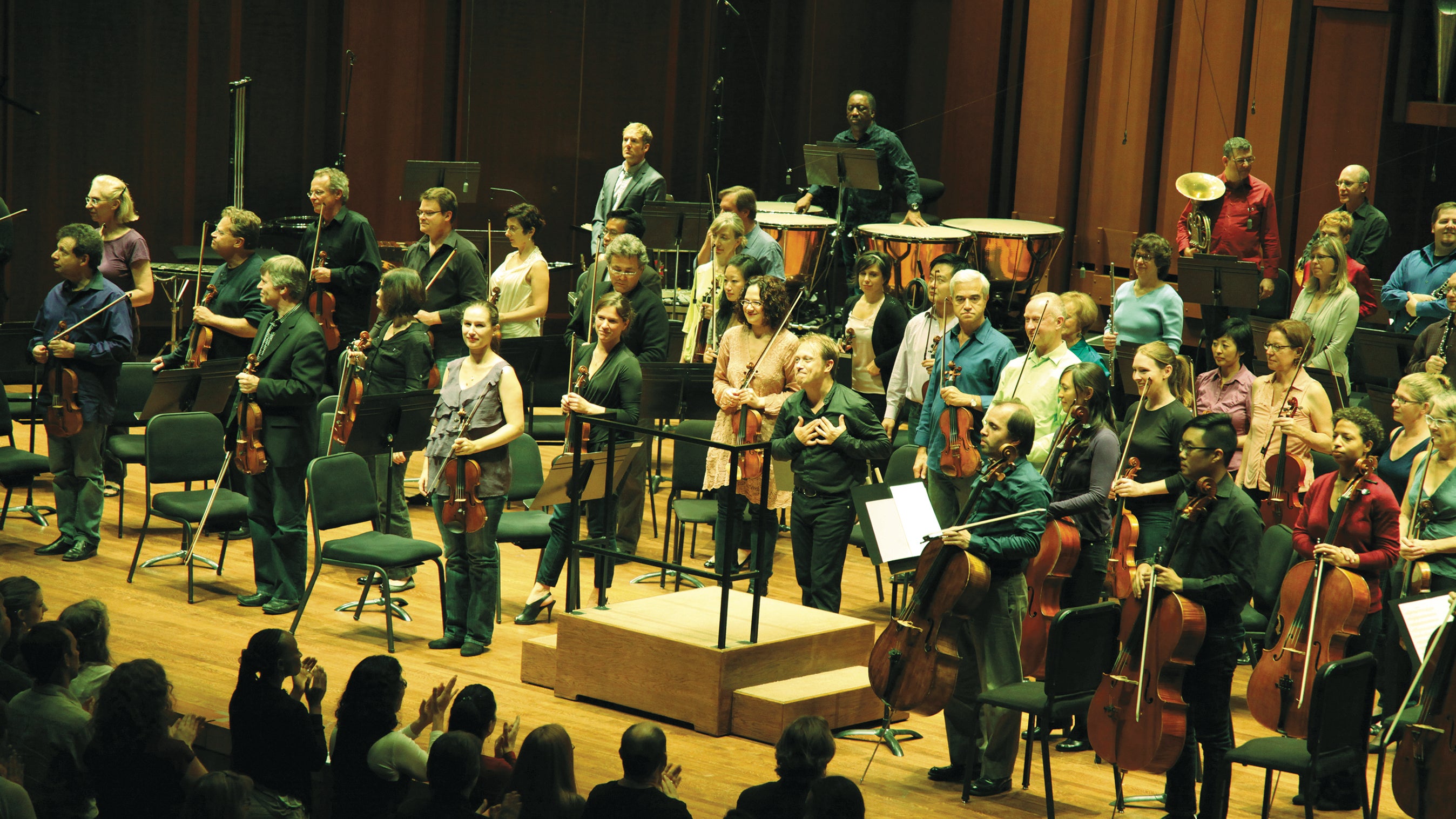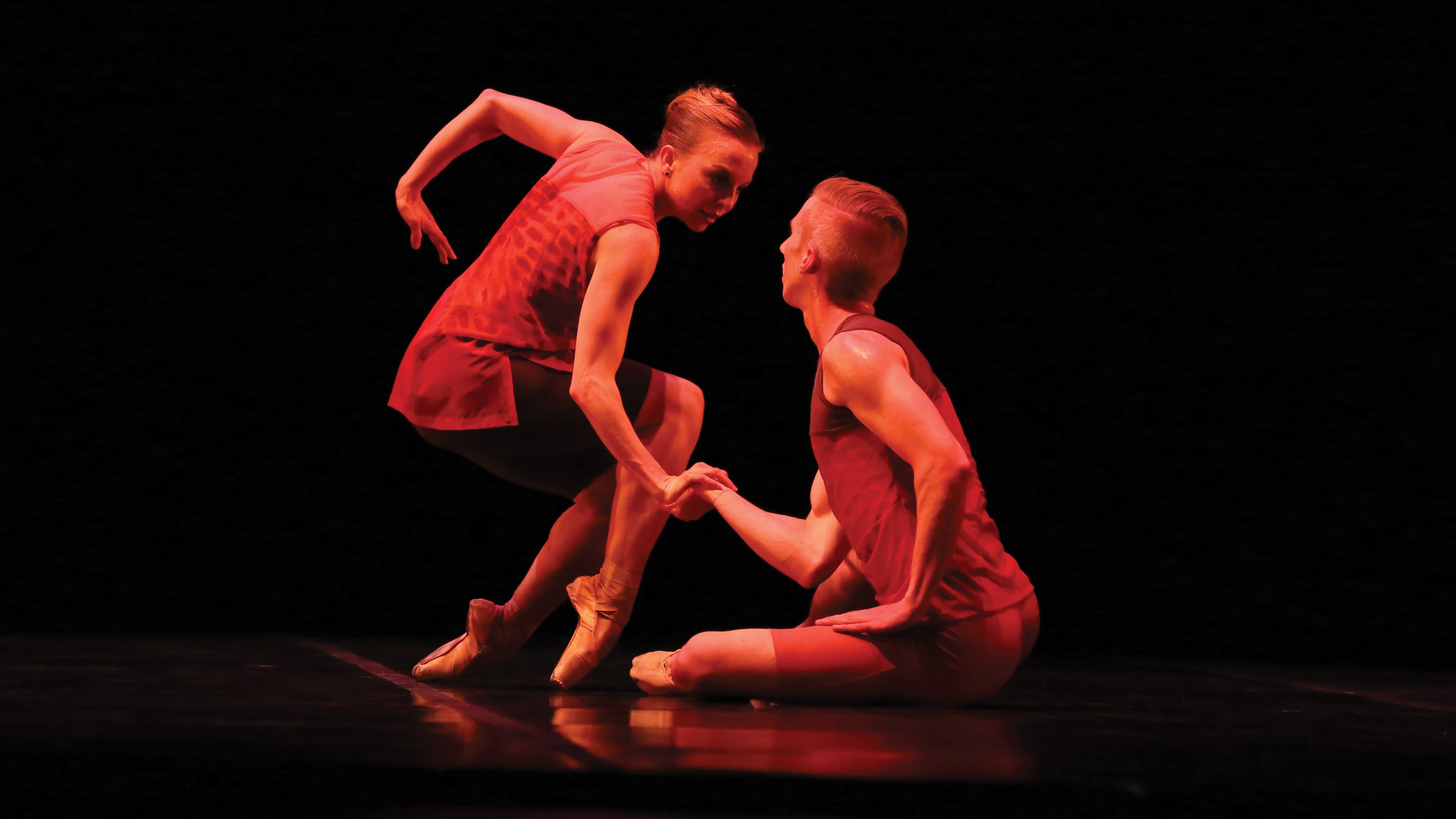Ballet Austin has embarked on a multiyear project to develop audiences for new works. Backed by market research, they've upended assumptions about their audiences to generate ideas, test results, and launch new strategies to bring in more people to less familiar performances.
Every December, Ballet Austin puts on “The Nutcracker,” choreographed by the company’s artistic director, Stephen Mills. Virtually all of the 14 performances at the 2,442-seat Long Center for the Performing Arts are filled to capacity. “We could sell out more shows,” says Cookie Ruiz, executive director of the Texas company, “but it would wear our dancers out.”
Packed houses are the case for other classics, too. But a different picture emerges for more abstract works, which don’t attract the crowds that flock to “Swan Lake,” “Sleeping Beauty” and the like. That reality is frustrating for the dance company – and not just because unsold tickets mean unrealized revenue. It also runs counter to Ballet Austin’s mission: to create new work and develop talent, thereby extending the ballet repertoire and advancing the art form. Ruiz sums up the problem with a simple question:
“How do we go about developing larger audiences for entirely new work?”
In 2015, Ballet Austin embarked on a six-year project to get some answers, spurred in part by a grant from The Wallace Foundation. Hewing to principles of what’s loosely known as “continuous improvement,” the ballet company has been conducting research, developing initiatives informed by what the research suggests, examining the results – and then launching new marketing strategies and engagement offerings based on the findings. Less than a year and a half into the venture, coordinators of the work at Ballet Austin have often been surprised by what they have learned – especially by the way research can upend even long-held assumptions.
Initial Assumptions
Ballet Austin presents what is known as neoclassical ballet, which runs a wide gamut. On the more traditional end of the spectrum, ballerinas are en pointe, upright and vertical, with men supporting them. Costumes are lavish, the sets opulent. On the more contemporary end of the spectrum, movements engage the dancers’ full bodies, costumes might be nearly as spare as leotards, and sets might be abstract, with fields of color or industrial-seeming paneling serving as backgrounds to the ensemble onstage.
The company is housed in and owns a two-story, 34,000-square-foot complex that includes seven rehearsal spaces, studios, and a 287-seat theater in downtown Austin, where it is difficult to turn a corner and not see a towering construction crane. Ballet Austin holds its performances off site at the Long Center, the city’s sleek, modern performing arts facility. When artistic, marketing and senior administrative staff members at the company first came together for this project, they set out to determine what was drawing people to the Long Center performances. They were not considering altering programming to meet audience tastes, but they hoped to understand how audiences were viewing and responding to what the ballet company produced.
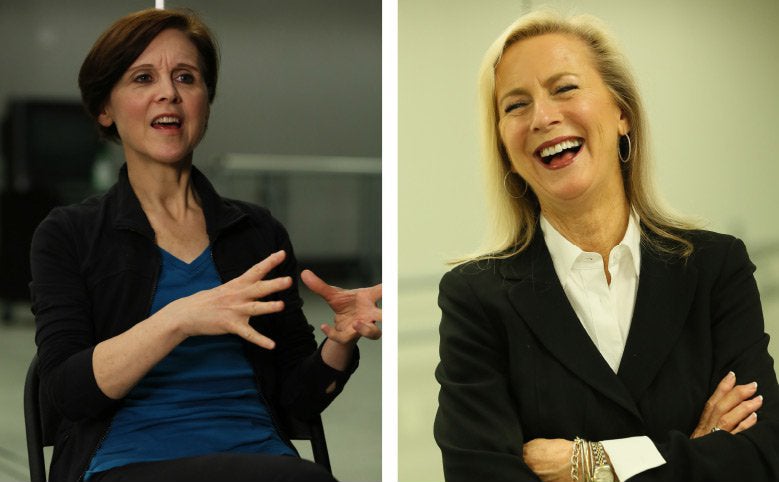
At first, Ruiz and Michelle Martin, Ballet Austin’s associate artistic director, sought to categorize performances by the style of movement, a way to help identify what qualities people responded to in a production. But too many shows fit into multiple categories, and tickets sales could vary within a single classification. One day while studying a whiteboard map of categories that the staff had been working on for a month, Ruiz had a revelation: “It’s not about whether it’s classical or neoclassical [or contemporary], but all of a sudden we realized [that it was] more about the familiarity [of the story rather] than the style.”
With this lens, they came up with new classifications. Category 1 included the classics, with much-loved music and a narrative story line. Category 2 included narrative ballets with a contemporary feel in dance, design and music, like Mills’s “Hamlet,” from 2000, which features music by Philip Glass and has now been licensed by six companies in the United States and one in Germany. Ballet Austin considers Category 2 its “sweet spot” because it allows the company to both present new work and fill the Long Center’s large auditorium with stories that audiences are familiar with.
Categories 3 and 4 were mixed repertoire productions: programs of a few shorter, non-narrative pieces, often more experimental and avant-garde. Category 3 productions provided some familiarity, such as music by Mozart or Bach, or choreography by Mills. Category 4 productions presented unfamiliar choreography and music.

Ballet Austin had a great hypothesis about audience behavior—until market research came in and revealed unexpected nuances in tastes, interests and behaviors.
The categories together suggested a “familiarity continuum,” which flowed roughly from Category 1 to 4 in a logical sequence, consistent with both ticket sales and research from 2001 that had revealed that most audience members first came for the classics and then, slowly, over a period of three to five years, cautiously explored newer works. Julie Loignon, director of audience engagement, sales and services, said she thought of the continuum like “a set of tracks that a customer would get on” and move from “The Nutcracker” to less familiar works.
And it was a great hypothesis – until market research came in and revealed unexpected nuances in audiences’ tastes, interests and behaviors.

Market Research
The company initially thought of building its audiences by going after Austin’s burgeoning population of affluent people who were socially active and social media savvy but might not know anything about Ballet Austin. In consultation with market research company Slover Linett Audience Research Inc., the audience-building team decided to focus on people who were not subscribers but came to a production every year or so. Looking at their audience numbers, they set aside people who came to “The Nutcracker,” because they were thought to be uninterested in non-narrative ballet. Even without the “Nutcracker” audiences, the team had a large pool to draw from: About 20,000 visitors attend productions besides “Nutcracker” each year, and 10,200 come through the doors for dance, health, and fitness classes. And there are 100 school-age children taking ballet classes, and their families.
The market research had three components:
- Four, two-hour focus groups comprising ticketbuyers selected according to the familiarity continuum category they had bought tickets for,
- A survey with questions derived from focus group findings as well as Ballet Austin’s assumptions about its audience members—their levels of familiarity with ballet movement and technique and their interest in new work,
- An analysis of the ticket database, looking for patterns of thought and behavior that the ticket buyers themselves might not be aware of.
The findings were extensive, requiring a major time commitment to process. Focus group videotapes and related transcripts took 180 hours of study by 12 staff members and a 10-member committee drawn from Ballet Austin’s engaged board of directors. The surveys, which netted 1,500 responses (well above the target of 1,200), yielded reams of executive summaries, analyses and charts, all of which had to be digested and analyzed.
One of the first things that jumped out was that while a majority of audience members first came to Ballet Austin for “The Nutcracker” or other classics, notable numbers entered the continuum through Category 3 and 4 ballets, and some of these attendees had little interest in traditional tutu and pointe-shoe productions. Further, some who came in through “The Nutcracker” moved next to more experimental work, skipping over more contemporary but familiar narrative ballets entirely.
That Ballet Austin’s audiences proved to be more fluid and open to experimental work was welcome news: It suggested the ballet company could reasonably hope to build its audiences for abstract productions with less resistance and in a shorter time frame than originally imagined.
The audience-building team learned that two factors brought the vast majority of people to the ballet: the social experience of spending time with family and friends at an event and the emotional or intellectual reward of experiencing the art itself. Some people were motivated by both factors.
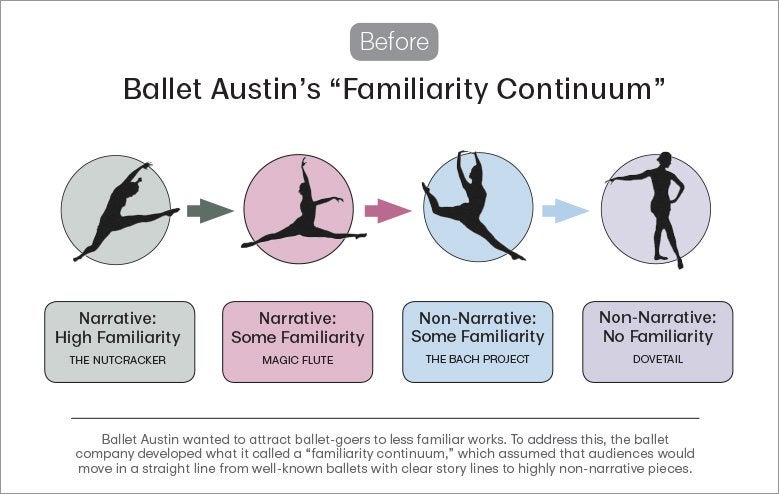
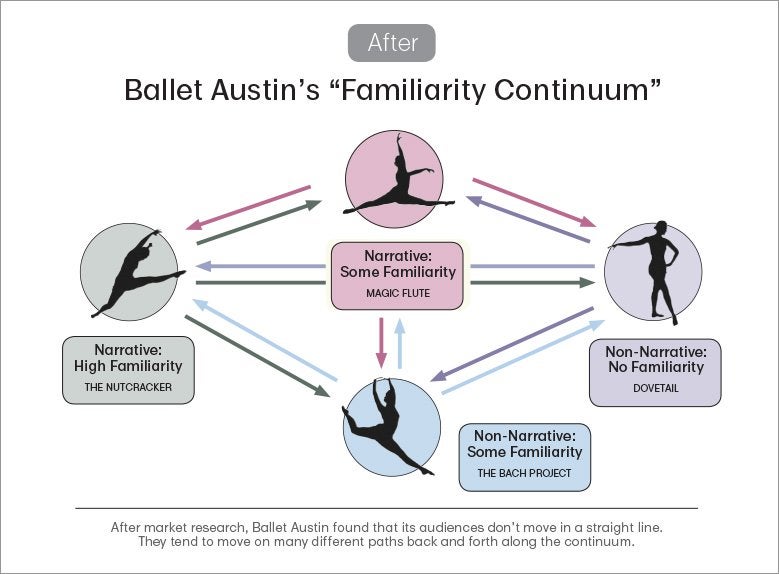
The research also provided insight into what triggered sales for particular ballets. As expected, familiarity with the ballet or story mattered in part. But would-be ticket buyers also sought reasonable certainty that they would enjoy the production and the evening.
In other words, the market research suggested that encouraging people to attend the ballet more often was less about increasing their familiarity with productions and more about bridging an uncertainty gap. “Familiarity is about information,” notes Martin, “whereas uncertainty about how an experience will feel is much more personal. You can give somebody a lot of information but that’s not necessarily going to reassure them that they’re going to belong in that audience.” And reassurance was key considering the costs of attending – tickets, parking, drinks or dinner, maybe a baby sitter – and the stress of traffic bred by Austin’s growing population and construction.

Familiarity is about information, whereas uncertainty about how an experience will feel is much more personal.
— Michelle Martin, associate artistic director, Ballet Austin
Audience uncertainty partly grew out of how Ballet Austin was presenting information about its productions. The research showed that images as well as the language used in promotional pieces, ads and even program titles, often created a disconnect. “What we thought we were saying was not what people were hearing,” Martin says.
The problem was especially glaring for abstract productions. Based on the promotional materials in some cases, prospective audience members simply couldn’t fathom what they would be seeing. An ad for a recent program, “To China With Love,” featured an image of two dancers seeming to float among clouds, which many found ambiguous. One person mistook it for a mattress ad. The confusion made Loignon wonder if Ballet Austin should consider cutting back on print ads for abstract ballets and investing more in online videos that show the work itself.
As for language, Ballet Austin was advertising and talking about the productions in what many prospective ticket buyers considered incomprehensible jargon, which made them feel ignorant and uncomfortable. Even a phrase as basic as “mixed repertoire” was alien to some.
Other findings suggested great opportunities, with the single biggest shock involving “Nutcracker” audiences. Conventional wisdom in the ballet world holds that “Nutcracker” attendees aren’t really ballet audiences. “They come once a year,” says Ruiz. “It’s not really for the ballet…. They’re playing out their relationship with their family.” The research found, to the contrary, that 60 percent of the annual “Nutcracker” audience – fully 18,000 people – were open to other ballet, whether narrative or abstract. And some of them, without any push from Ballet Austin, were already going on to other productions.
With the data and other findings in hand, Ballet Austin realized that building audiences for contemporary works – its goal all along – would require a series of new initiatives and strategies. The audience-building team members needed to find ways to bridge the uncertainty gap, enhance social interactions and remain open to audience feedback, particularly because the audiences were more fluid than they had realized.
With the data and other findings in hand, Ballet Austin realized that building audiences for contemporary works – its goal all along – would require a series of new initiatives and strategies. The audience-building team members needed to find ways to bridge the uncertainty gap, enhance social interactions and remain open to audience feedback, particularly because the audiences were more fluid than they had realized.

Bridging the Uncertainty Gap
One of the first steps involved reviewing a longstanding pre-performance activity, “Studio Spotlight,” which opened rehearsals for an upcoming production to up to 500 people. Though popular, Studio Spotlight rarely led to new sales; the event was preaching to the choir.
In response, Pei-San Brown, Ballet Austin’s community education director, and Loignon, director of audience engagement, sales and services, devised Ballet Austin Live!, which allowed more people to get a sense of a production beforehand through a 30-minute live-stream of a rehearsal. The script, which included a brief introduction by Mills with commentary and discussion from others, avoided ballet jargon. The production enlisted both professional and in-house videographers, including an ensemble member who weaved among the dancers on a skateboard while filming, creating a compelling and raw sense of immediacy.
Early results are mixed but encouraging. A September 2016 production of the Category 3 “To China With Love” generated 585 unique views of the rehearsal. But in one earlier Ballet Austin Live! stream of a Category 3 production, the video, captured and posted to Ballet Austin’s Facebook page and to YouTube, generated more than 1,000 views. Without question, Ballet Austin Live! is helping bridge the uncertainty gap, but whether it will result in ticket sales remains an open question in the project’s early days.
Creating Opportunities for Social Interaction
Though it has taken various forms, an event known as Ballet Bash! is meant to facilitate social gatherings before a performance and during intermission. One time, Bash! included a DJ for a pre-performance party with refreshments. The cost outweighed the benefits, however, so Ballet Austin cut the DJ and instead offered carefully selected music in an area at the Long Center with spectacular views of Austin’s expanding skyline. That iteration was modestly attended. For a later production, Ballet Bash! was replaced by a social lounge in a smaller, more intimate wing of the Long Center’s mezzanine. At recent performances, around 15 people were sitting in small groups during the hour before the performance and intermission, which Ballet Austin considered a promising start.

Another new offering, Ballet-O-Mania!, an interactive exhibition that opens an hour before the curtain goes up and during intermission, has a social aspect to it, too, even if its primary purpose is to help fill the uncertainty gap. At a series of stations audience members can explore and learn about the day’s production or ballet in general. Before one September performance of “To China With Love,” a girl, perhaps 8 years old, showed her grandmother how to use a tablet to learn about the featured composers and their pieces. At a table display, people could see such tools of the trade as pointe shoes, bisected to show what dancers’ toes are scrunched into. A plastic sound dome enabled visitors to preview the music they would be hearing without adding to the din of the room. At another station, vinyl dance flooring laid atop carpeting provided a smooth surface on which Ballet Austin apprentice dancers taught people basic ballet moves – an especially popular feature with young girls, much to their parents’ delight.
During the September “To China With Love” production, 905 people stopped in to check out Ballet-O-Mania! over the three-day run – an encouraging sign. For a different Category 3 production, nine months earlier, the total had been 824. The increase suggested that Ballet-O-Mania! was gaining traction. Planners are now considering adding stations with information about upcoming productions, which might trigger direct ticket sales.
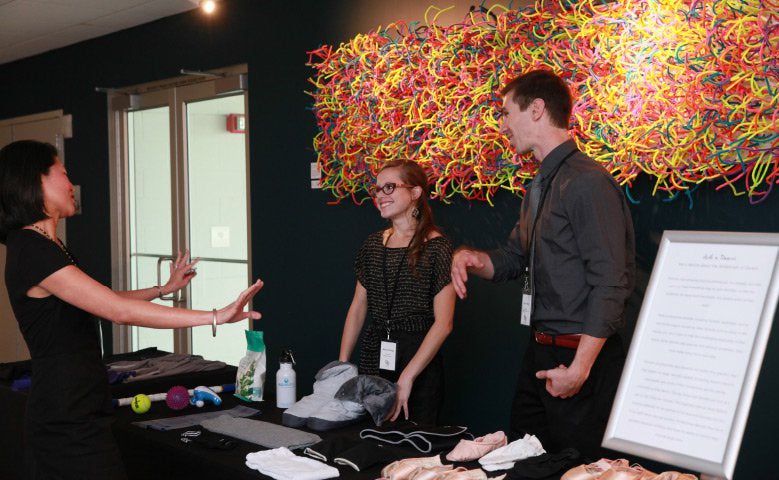
Accounting for Audience Fluidity
What do audience members think of all this? Conversations with a dozen of them during two productions – the Category 3 “The Graham Reynolds Project,” featuring Mills’s choreography with music by Reynolds, a nationally successful and locally based composer, arranger and performer, and the Category 3 “To China With Love” – reflected an open-eyed curiosity and interest. A retired couple who had recently moved to Austin very much enjoyed “Reynolds,” even though it featured three abstract works, electronic music and multihued lighting. “I loved the music,” said the woman, “and the [dance] movements were so interesting.” It was their first Ballet Austin performance, and they said they would return.
A middle-aged couple who had lived in the area for years without attending a Ballet Austin performance came to see “To China With Love.” “I get a lot of emails from Ballet Austin,” the wife said, suggesting that Ballet Austin’s expanding email campaigns are bearing fruit. She’s a fan of composer Philip Glass, whose music was featured in one of the productions, and, by chance, her sister-in-law, who works with a Minnesota dance company, had recently been in town and lamented the diminishing audiences for the company she worked for. “I thought, ‘We need to support this or it might go away.’” Both she and her husband said they “loved the performance” but hadn’t checked out Ballet-O-Mania! – and they wondered aloud how they could volunteer for the company.
Continuous Improvement
Ballet Austin is using what it is learning through market research to see what works and what doesn’t – and to change its practices accordingly. After finding that “Nutcracker” audiences were open to abstract work, for example, Loignon expanded the email list for the Category 3 “To China With Love” to include “Nutcracker” fans, a move that led to a doubling of daily sales from about $1,500 to $3,000. On the other hand, the ballet company has taken the less successful Studio Spotlight off the table, replacing it with the promising Ballet Austin Live! The question now is whether the performances actually need to be live or whether they can be filmed and posted to Facebook and YouTube on demand, eliminating the expense of a live feed.
Everything is open for discussion, including the question of costs versus benefits. Initiative expenses have included, among other things, new hires in digital content production and in education, camera crews, and materials such as tablets and monitors for Ballet-O-Mania! Whether the results justify such costs may not be determined for years.
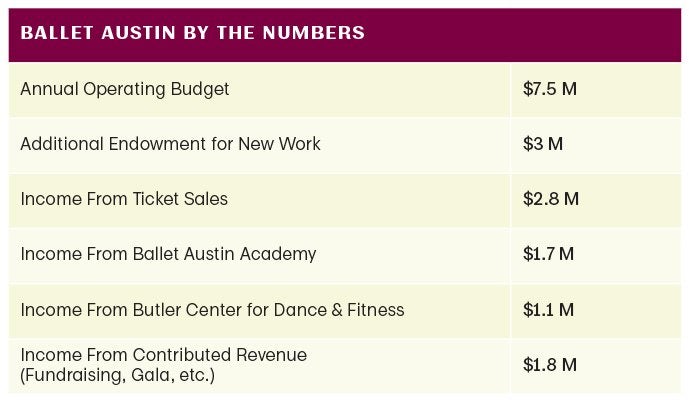
Which leads to the big question: How close is Ballet Austin to developing a sustainable audience for unfamiliar work? The search for the answer, through the process of continuous learning and refinement, is ongoing. “We know so much more than we did 14 months ago,” says Ruiz. “But we’re barely into year two of a six-year process. You know, we don’t pretend to have all the answers. We still have so many questions.”
Everything is open for discussion, including the question of costs versus benefits. Initiative expenses have included, among other things, new hires in digital content production and in education, camera crews, and materials such as tablets and monitors for Ballet-O-Mania! Whether the results justify such costs may not be determined for years. Which leads to the big question: How close is Ballet Austin to developing a sustainable audience for unfamiliar work? The search for the answer, through the process of continuous learning and refinement, is ongoing. “We know so much more than we did 14 months ago,” says Ruiz. “But we’re barely into year two of a six-year process. You know, we don’t pretend to have all the answers. We still have so many questions.”
This article and video are part of a series describing the early work of some of the 25 performing arts organizations participating in The Wallace Foundation’s $52 million Building Audiences for Sustainability initiative. Launched in 2015 in response to concerns about a declining audience base for a number of major art forms, the endeavor seeks to help the organizations strengthen their audience-building efforts, see if this contributes to their financial sustainability, and develop insights from the work for the wider arts field.
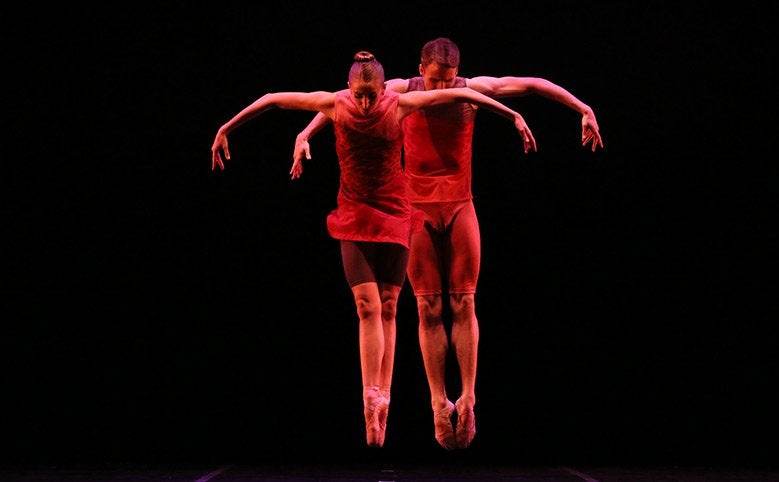
Start a Discussion
The purpose of this Discussion Guide is to help arts administrators, board members and arts practitioners working within varying disciplines and with a range of budget sizes to better understand and apply lessons from another institution’s experience to their own context. The guide can serve as a teaching aid for small-group discussions, as well as individual study. It is designed to be used in conjunction with the written and/or video versions of the story.
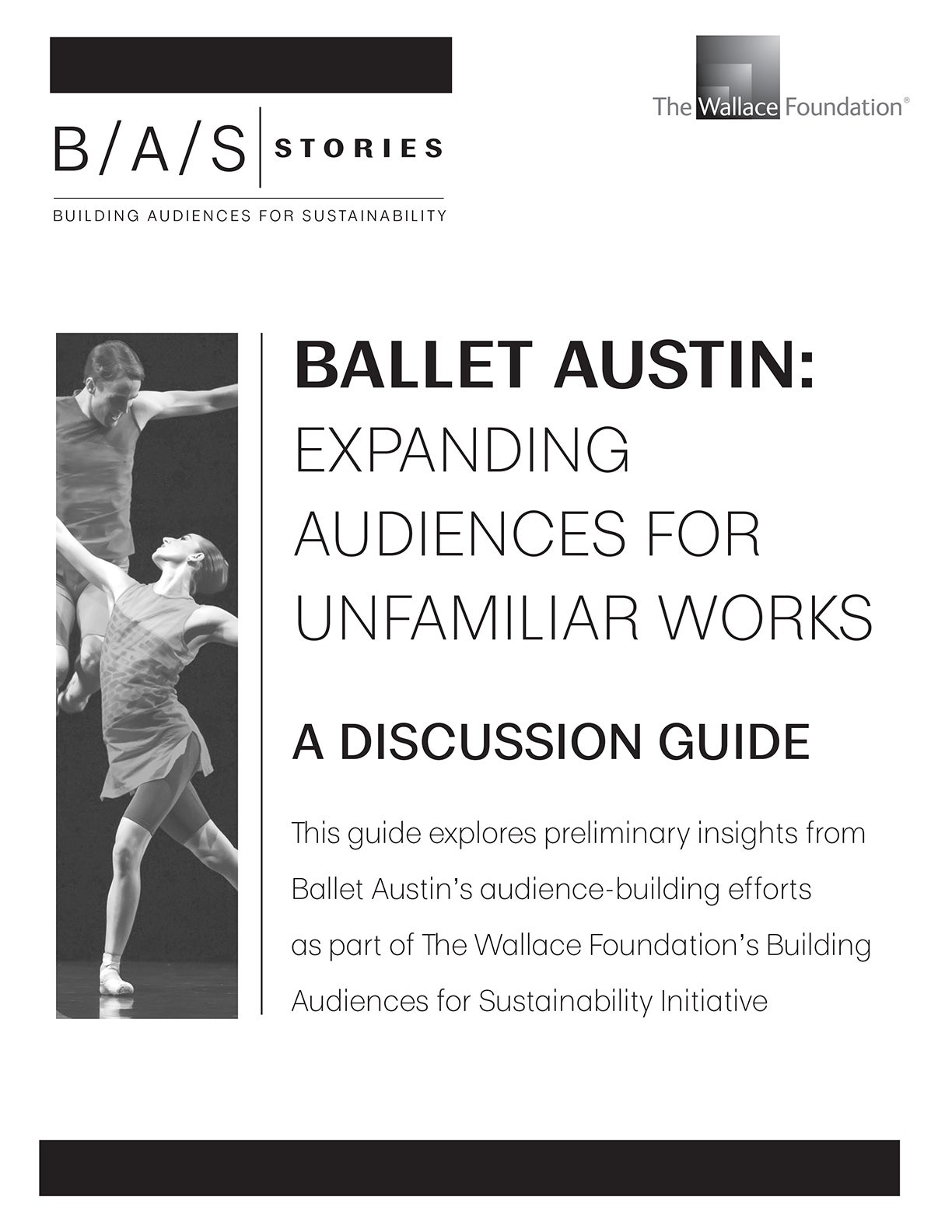
Stories in Building Arts Audiences
